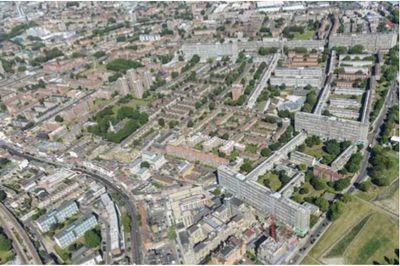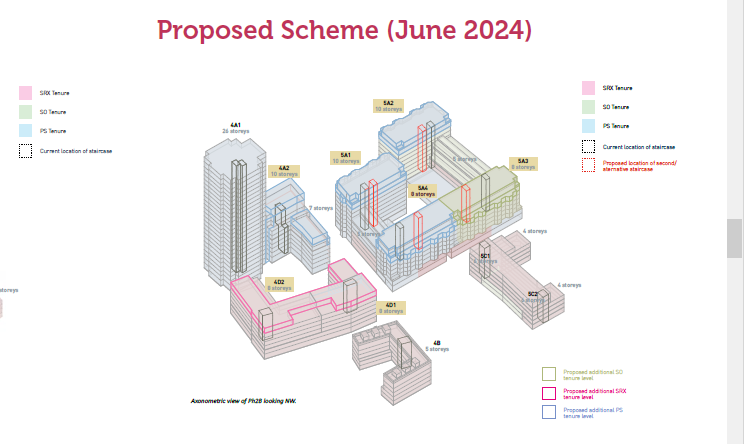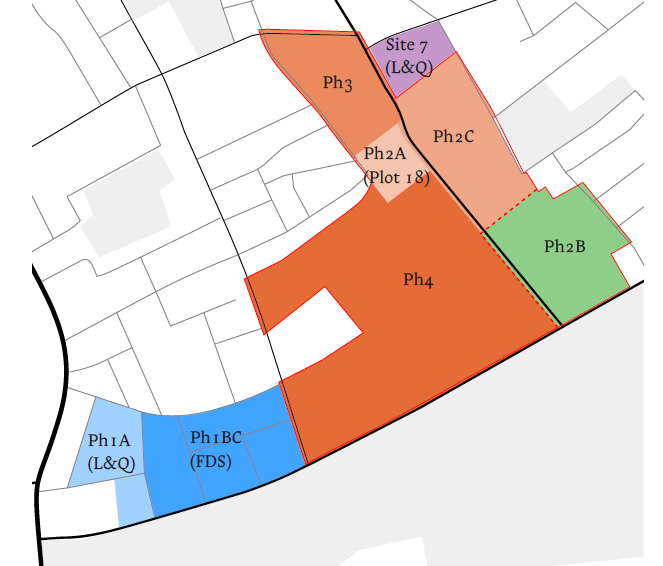
Notting Hill Genesis (NHG) have updated their planning application for Phase 2B of the Aylesbury regeneration. The new proposal increases the number of homes from 617 to 640, with an increase in the number of social rented homes from 163 to 173 and of intermediate part-buy/part-let homes from 82 to 89. The number of private homes has been increased to 378 from 369.
There will also be an additional floor on seven of the eleven buildings. All the blocks are between five and ten storeys, with one tower of 26 storeys, which remains the same height [^1].
The updated Phase 2B application retains the same reference number, 22/AP/2226, as the original application, made in June 2022. This was approved by Southwark Council's planning committee in January 2023, but not concluded by a legal agreement, after it became entangled in a High Court action last year. This led to NHG's attempt to change its separate Outline Planning Permission (for rest of the estate) being quashed.
NHG say now that an updated Phase 2B application is necessary because of new fire safety requirements, including the need to add second staircases to four of the blocks.

184 social rented homes will be lost
The redevelopment of Phase 2B entails the demolition of 241-471 Wendover, Padbury, Winslow and Ravensbourne, with the loss of 373 homes, of which 327 remain council housing, giving a net loss of 154 social rented homes, if NHG's proposals are approved [^2]. This rises to 184 once we include the 30 maisonettes already demolished on the Foxcote block.
NHG abandons the OPP
The application also remains 'drop-in' or 'standalone' application, outside the parameters of the Outline Planning Permission (OPP). NHG already holds this permission for Phase 2b, Phase 2c, Phase 3 and Phase 4.
NHG says that it is submitting a 'standalone' application because it cannot complete the scheme within the OPP masterplan timescale. NHG also say that the OPP will not allow the development to meet the Mayor's policy requirement that demolished affordable housing must be replaced by an equivalent amount of affordable housing floorspace [^3].

More or less social rented housing?
NHG claim that the updated 'standalone' application improves the amount of social rented housing, when measured by habitable room and floorspace, over both the Outline Planning Permission and the scheme approved by the planning committee in January 2023. This is despite the loss of 154 social rent units, measured against what will be demolished; NHG concedes this loss, but say 'due to the larger number of family units (of 3+ beds), the number of habitable rooms has increased' [^4].
However, the amount of family-housing proposed by NHG fails to meet Southwark's policy requirements, on at least three measures;
- A minimum of 70% 2+ bed homes is required; only 64.5% is proposed.
- A minimum of 20% family homes with 3+ beds is required; only 15.94% is proposed
- A minimum of 3% 5-bed homes is required; only 1.72% is proposed.
One measure is met - a minimum of 7% 4-bed homes is required and 7.66% is proposed.
There is no ready information about the number of 2 bed/3 person and 2 bed/4 person homes, nor if there will be any studio flats (a maximum of 3% are allowed as private housing) [^5].
Also, while NHG claim that the number of social rented habitable rooms will increase overall, they do not give a baseline figure for what already exists on Phase 2B, against which to measure this claim. The January 2023 planning committee report says that there will be an uplift of 254 habitable rooms, but calculates this on an implausibly low figure of 484 habitable rooms for the existing 327 council homes. This would only be an average of 1.48 hb rm per dwelling, when the average for social housing across the whole estate is 3.06 hb rm per dwelling [^6].
No houses
There will also be no houses on Phase 2B, although the number of maisonettes will be greater than that required by policy (20% against 17%) [^7].

This is a significant departure from the original Aylesbury plans. The now discarded Aylesbury Area Action Plan 2010 (AAAP), emphasised the benefits of houses as a type of family home. The AAAP defines a house as a 'self contained residential dwelling. Houses can be detached, semi detached or terraced' [^8] and promised that nearly a quarter of the new homes would be houses, saying 'We will respond, for example, to the needs of families...........23% of new homes will be houses with access to gardens' [^9].
The AAAP notes that 'Increasing the proportion of homes suitable for families was a key concern which local residents raised during consultation' and 'Providing a high proportion of houses will enable more households to have their own front doors which open onto the street and will also help minimise common parts. This will increase street level activity and will reduce many of the problems associated with higher density living. It also reduces the management costs for residents' [^10].
Four reasons not to give Phase 2b planning permission
On the face of it a proposal for 640 new homes, with relatively generous proportions of affordable and social rented housing is attractive. But there are at least four reasons why planning permission should not be given;
- There will be a net loss of social rented housing, at a time when the housing waiting list stands at over 17,500 households
- Notting Hill Genesis proposals fail to meet Southwark's minimum requirements for larger, family homes
- Southwark Council promised that nearly a quarter of the new homes on the Aylesbury would be houses, because they are good for families and that is what residents wanted - NHG are proposing zero houses for Phase 2B.
- The Aylesbury Area Action Plan was discarded in 2021 and now the Outline Planning Permission is being abandoned for Phase 2B. Without these, Southwark and NHG no longer have any coherent plan for the remainder of the regeneration. Approving the same 'standalone' application that has already occasioned a successful legal challenge puts the future of the regeneration, under the OPP, into futher doubt.
[^1] Planning Statement Addendum, Oct 2024, 22/AP/2226 - find via https://planning.southwark.gov.uk/online-applications/applicationDetails.do?activeTab=documents&keyVal=RDU2YJKB00300; Public consultation June 2024, exhibition board 9 http://www.aylesburynow.london/web/uploads/files/news_254_0.pdf?nocache=4626
[^2] Officer's report 22/AP/2226, 17 Jan 2023 para 31; Existing Site Plan - find via https://planning.southwark.gov.uk/online-applications/applicationDetails.do?activeTab=documents&keyVal=RDU2YJKB00300
[^3] Officer's report 22/AP/2226, 17 Jan 2023 para 23
[^4] Planning Statement Addendum, Oct 2024, Section 7, Affordable Housing Provision, 22/AP/2226 - find via https://planning.southwark.gov.uk/online-applications/applicationDetails.do?activeTab=documents&keyVal=RDU2YJKB00300
[^5] Planning Statement Addendum, Oct 2024, 6.35, 6.36, 22/AP/2226 - 6.56% x 3 bed, 7.66%x 4bed, and 1.72% x 5 bed. Find via https://planning.southwark.gov.uk/online-applications/applicationDetails.do?activeTab=documents&keyVal=RDU2YJKB00300
[^6] Officer's report 22/AP/2226, 17 Jan 2023 para 128. A habitable room is one that is used for living, sleeping, eating or cooking (not a bathroom). The figures used to calculate the average number of habitable rooms for social housing on the whole estate come from the Officer's report 14/AP/3844, 23 April 2015, para 89.
[^7] Planning Application Design and Access Statement, May 2022, 1.1 Executive Summary 22/AP/2226 - find via https://planning.southwark.gov.uk/online-applications/applicationDetails.do?activeTab=documents&keyVal=RDU2YJKB00300
[^8] AAAP 2010 Glossary, pg 178
[^9] AAAP 2010 Foreword pg 3; The vision and plan objectives 1.6.4
[^10] AAAP 2010 Types of Home, 3.5.3, 3.5.4